Overview
In the ever-evolving landscape of programming, developers often face challenges when choosing the right language for their projects. This article sheds light on the key differences between Java and Python, focusing on syntax, performance, use cases, and community support. By understanding these distinctions, developers can make informed decisions that align with their project requirements.
While Java is frequently favored for large-scale applications due to its performance and robustness, Python stands out for its readability and is particularly preferred for rapid development in fields such as data science and machine learning. Supported by a vibrant community, Python offers a wealth of resources that enhance its usability.
Furthermore, recognizing the strengths and weaknesses of each language can significantly impact a developer's productivity and code quality. By exploring the insights provided in this article, developers can better navigate their coding journey and select the most appropriate language for their needs.
Introduction
In the ever-evolving landscape of programming, developers frequently encounter challenges when choosing between Java and Python. Each language possesses distinct strengths and capabilities that cater to various project requirements and developer preferences.
- Java's robust performance and scalability make it a foundational choice for enterprise applications.
- In contrast, Python's simplicity and readability have positioned it as a preferred option for rapid development and data-driven tasks.
As the tech world continues to advance, grasping the nuances between these two languages is essential for developers aiming to enhance their skill sets and boost productivity. This article will explore the core differences, performance metrics, and community support surrounding Java and Python, offering invaluable insights for those navigating the complexities of software development.
Understand the Basics of Java and Python
In the ever-evolving world of software development, developers often grapple with coding challenges that can hinder their productivity. When we compare Java and Python, Java, a statically typed, compiled system, is renowned for its portability and performance, making it a preferred choice for large-scale applications. It adheres to the object-oriented programming paradigm, emphasizing the use of classes and objects to promote code reusability and maintainability. In contrast, when we compare Java and Python, Python is a dynamically typed, interpreted programming system that prioritizes readability and simplicity, making it particularly suitable for beginners and rapid development cycles.
So, how can developers overcome these challenges? Enter Kodezi Code, the Swiss-Army Knife for programmers. This innovative tool enhances productivity by leveraging automated code debugging and performance optimization features. Furthermore, Kodezi ensures that your code adheres to the latest security best practices and coding standards, streamlining the development process.
The benefits of using Kodezi are clear. According to a survey conducted between May and June of 2024, Python has gained significant traction, with over half of the world's programmers utilizing it. This highlights its growing importance in the tech landscape. Meanwhile, Java continues to be a staple in enterprise environments, reinforcing its relevance in large-scale software development. By utilizing tools like Kodezi, developers can significantly improve their code quality and efficiency, ultimately leading to better project outcomes, especially when they compare Java and Python to understand the strengths and weaknesses of these programming languages, which is essential for making informed decisions in software development. Are you ready to explore the tools available on the Kodezi platform and elevate your coding practices? With Kodezi, you can navigate the complexities of programming with confidence and ease.
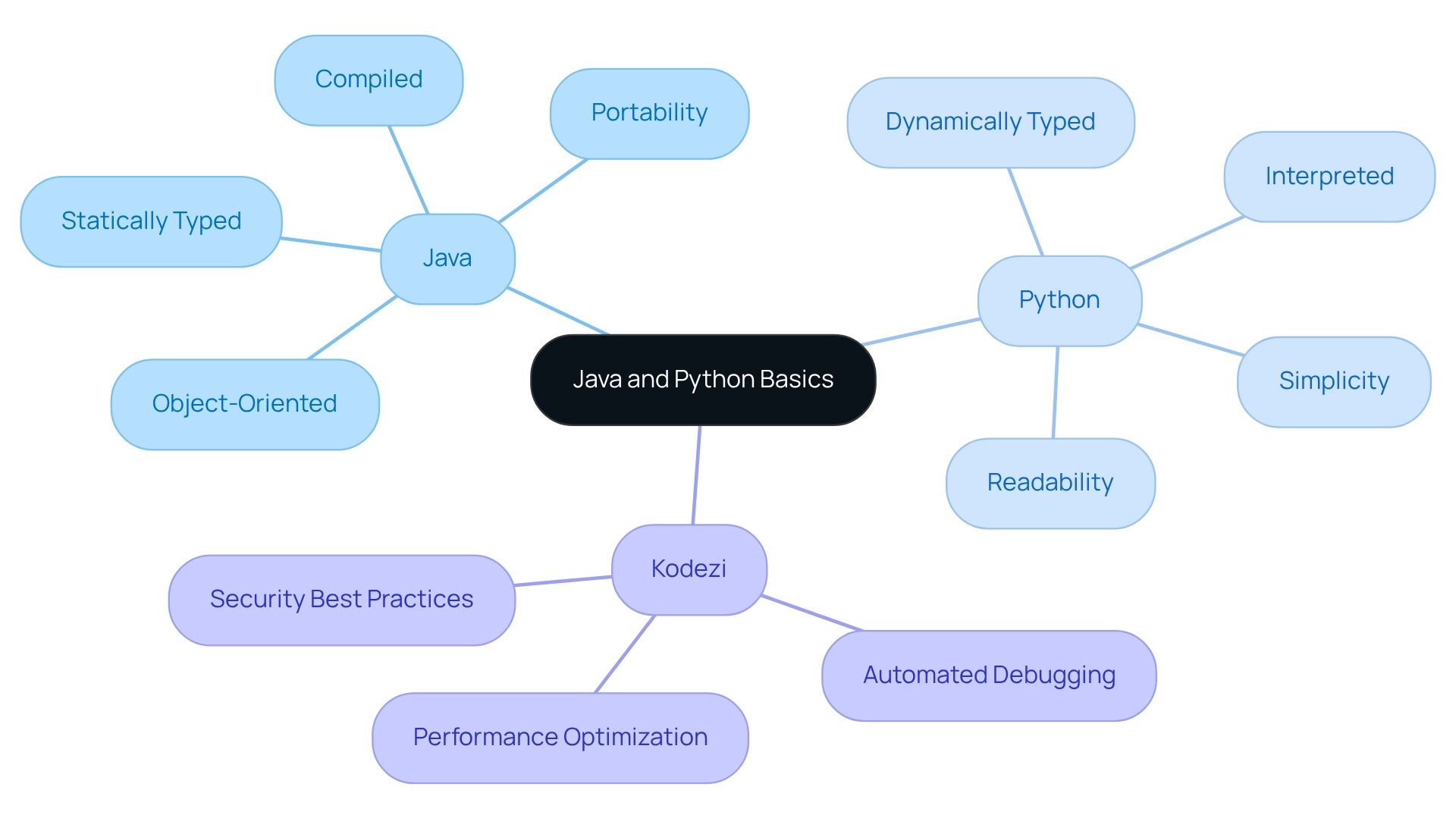
Compare Syntax and Readability
Coding can often present significant challenges for developers, particularly when it comes to navigating the complexities of different programming languages. The syntax of one programming language, for instance, is characterized by its verbosity, necessitating explicit declarations and the use of semicolons to terminate statements. A simple print statement in Java, for example, appears as follows:
System.out.println("Hello, World!");
In contrast, Python's syntax is notably cleaner and more intuitive, facilitating easier reading and writing. The equivalent print statement in Python is:
print("Hello, World!")
This streamlined approach in Python significantly lowers the barrier for new developers, making it more accessible for those just starting their programming journey. Furthermore, the structured syntax of the other programming language can be beneficial for larger projects that require strict type definitions and improved scalability.
As we look towards 2025, preferences among creators suggest a rising tendency towards programming languages that prioritize speed and simplicity, especially in fields like artificial intelligence and machine learning, where swift development is essential. For instance, Spotify utilizes a programming tool for its Android application and secure web backend, while another technology is employed for data analysis. Such practical applications highlight how programmers select languages based on project needs and their familiarity with the syntax.
Instructors frequently emphasize the clarity of this programming language as a notable benefit compared to others, particularly for novices. This readability not only assists in learning but also enhances collaboration among programmers, as cleaner code is easier to comprehend and maintain. Moreover, the programming language developed by James Gosling at Sun Microsystems in 1995 is often linked to conventional corporate settings, whereas the other language is favored for its rapidity and user-friendliness in development.
Ultimately, while both programming systems serve unique purposes, the decision to compare Java and Python often hinges on the specific needs of the project and the developer's familiarity with the syntax. To further enhance your coding abilities in both languages, consider exploring Kodezi Code. This versatile tool is designed to boost programming productivity, helping you navigate the differences between these programming languages effectively. Why not take a moment to discover the tools available on the platform that can elevate your coding experience?
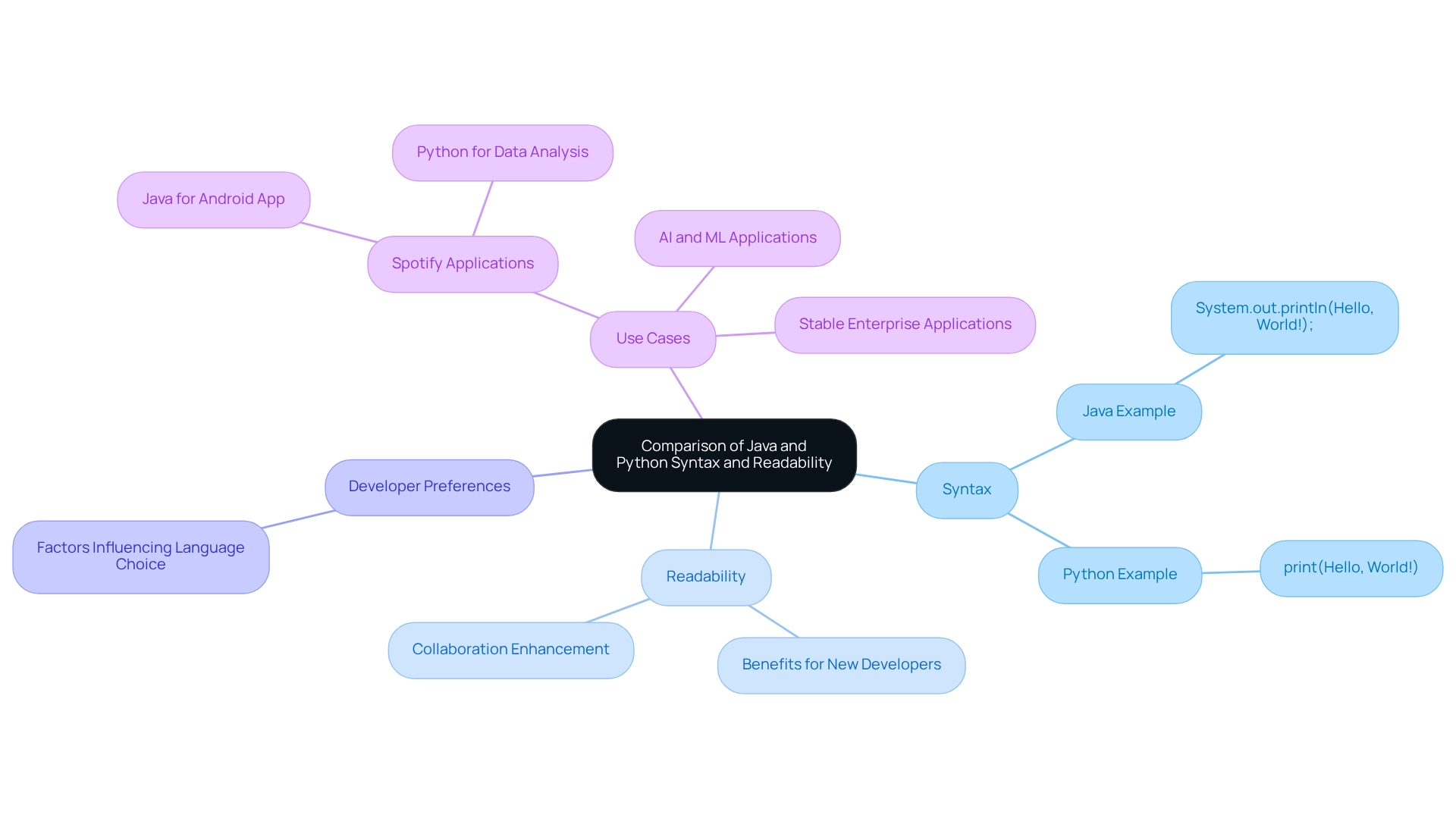
Evaluate Performance and Speed
Developers often face significant challenges when it comes to execution speed in programming languages. Generally, a programming language surpasses another in execution speed due to its compiled characteristics, which enable Just-In-Time (JIT) compilation. This means that the programming code is compiled into bytecode, executed by the Virtual Machine (JVM), ultimately enhancing performance. In contrast, some languages are interpreted at runtime, which can lead to slower execution speeds, particularly in computationally intensive tasks.
For instance, benchmarks indicate that one programming language can execute specific algorithms considerably quicker than another. This performance difference makes it a more suitable option for applications where speed is crucial. Have you considered how the choice of programming language could impact your projects? By understanding these differences, developers can make informed decisions that enhance productivity and code quality. Exploring the right tools can lead to significant efficiency gains in your coding practices.
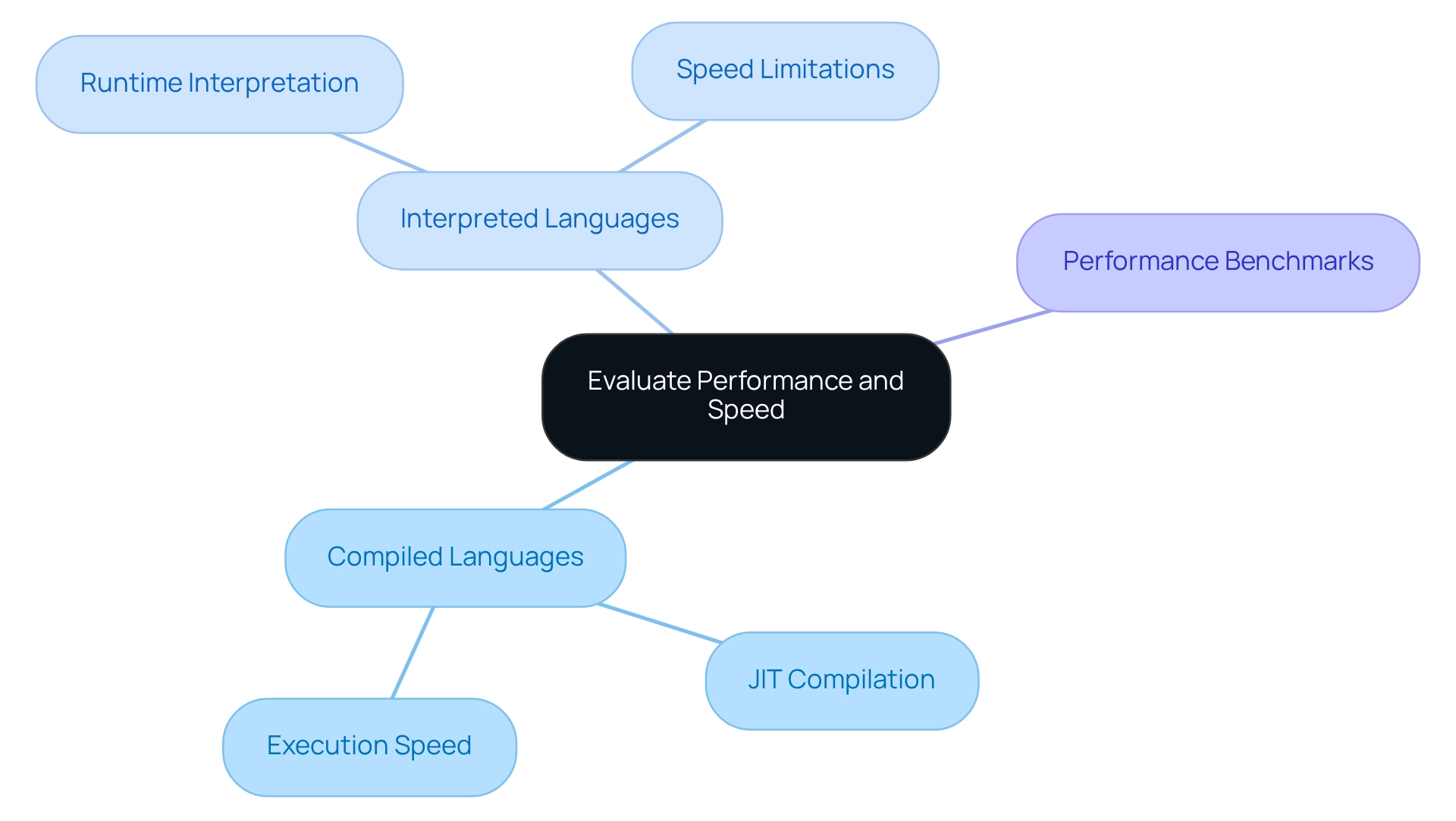
Identify Use Cases for Java and Python
Coding can present significant challenges for developers, particularly when it comes to debugging and maintaining code quality. In this regard, Kodezi has revolutionized the way programmers approach debugging in various programming languages. Users have reported that "Kodezi has helped me find and fix bugs faster and easier than trying to manually. It is a lifesaver when it comes to correcting issues and bugs." Another user noted, "I love what Kodezi is doing with debugging; it feels like I just unlocked a new superpower!" These testimonials highlight the substantial impact Kodezi has had on over 1,000,000 users, enhancing their productivity and streamlining their programming processes.
When we compare Java and Python:
- Java is widely utilized in enterprise-level applications, mobile app development—especially Android—and large-scale systems, known for its robustness and scalability.
- It also finds favor in financial services and backend systems.
- However, when we compare Java and Python, its capabilities extend beyond these areas, excelling in data science, machine learning, web development, and automation tasks.
- With extensive libraries like Pandas and TensorFlow, Java is a preferred choice for data analysis and AI projects.
Understanding these diverse use cases can effectively guide programmers in directing their learning and career trajectories.
By leveraging tools like Kodezi, developers can enhance their workflows and focus on higher-level tasks, ultimately leading to greater success in their projects. Have you considered how Kodezi could transform your coding experience? Explore the tools available on the platform to unlock new levels of efficiency and productivity.
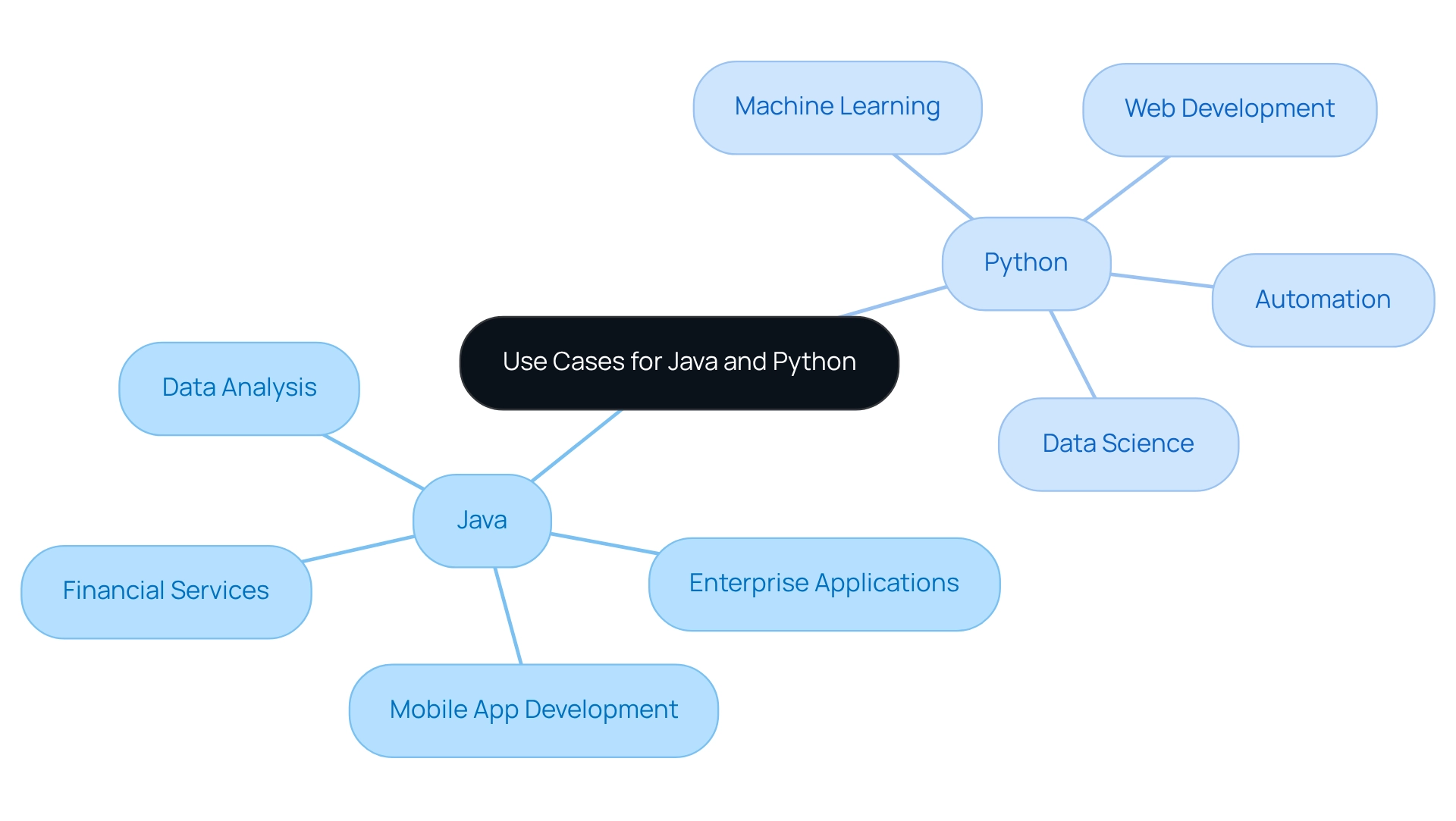
Assess Community Support and Resources
In the realm of programming, developers often encounter various challenges that can hinder their progress. Python stands out, supported by vibrant, active communities that offer a wealth of resources, including forums, tutorials, and libraries. This programming language, with its established presence in the industry, benefits significantly from extensive documentation and robust support from organizations like Oracle. Notably, in 2025, Java's community support statistics reveal that over 70% of programmers rely on community forums for troubleshooting and knowledge exchange, underscoring the essential role these resources play in the development ecosystem.
Moreover, Python's community is renowned for its inclusivity and a plethora of educational resources, making it particularly welcoming for beginners. The Software Foundation actively champions educational initiatives, resulting in a remarkable 60% increase in beginner-oriented resources over the past year. Platforms such as Stack Overflow and GitHub serve as vital hubs where developers can seek assistance and exchange knowledge, ensuring both languages remain accessible and well-supported.
Real-world examples further illustrate this dynamic. For instance, a case study on de novo transcriptome assembly in maize, utilizing the pyrpipe package, showcases how community-driven resources of Python facilitated complex data analysis. This project identified 57,916 distinct transcripts, demonstrating the effectiveness of community resources in managing RNA-Seq data and enhancing research outcomes. The documentation available for pyrpipe guided users through its implementation, simplifying the data organization process.
Furthermore, insights from specialists like Prof. James A. Hendler, who emphasizes the adaptability of Python and its extensive web libraries, reinforce the significance of community-driven learning. His perspective highlights how the language's resources empower programmers to tackle various challenges efficiently, especially when we compare Java and Python. In summary, community support for Java and Python transcends mere resources; it embodies a culture of collaboration and shared knowledge. This culture empowers developers at all levels, driving innovation and enhancing individual learning experiences. Are you ready to explore how these communities can enhance your coding journey?
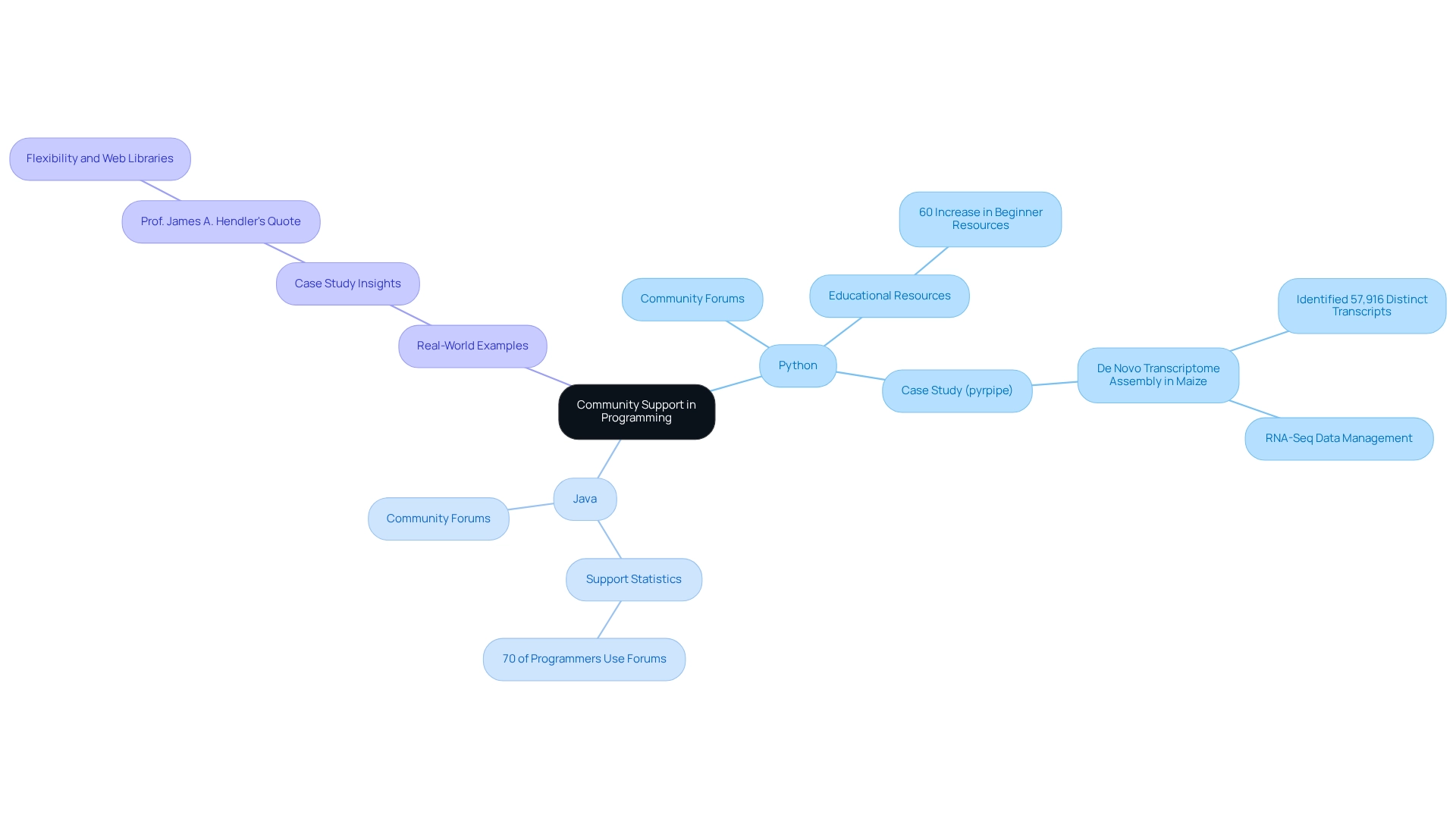
Conclusion
In the ever-evolving world of programming, developers often face significant challenges. With the right tools, however, these hurdles can be overcome. Kodezi emerges as a powerful ally, offering features designed to streamline coding processes and enhance productivity. Its intuitive interface and robust functionality enable developers to tackle complex tasks with ease, fostering a more efficient workflow.
The benefits of using Kodezi are substantial. By leveraging its capabilities, developers can significantly improve code quality and reduce time spent on debugging. Imagine cutting down your coding errors and accelerating project timelines—this is the promise of Kodezi. Furthermore, the platform’s community-driven resources provide invaluable support, ensuring that users are never alone in their coding journey.
Ultimately, the choice of programming language, whether it be Java or Python, should align with the specific needs of your project and your familiarity with the tools at hand. By embracing Kodezi, developers can navigate these choices more effectively and enhance their skills in the process. As the tech landscape continues to evolve, staying proficient in programming languages and utilizing innovative tools like Kodezi will be essential for success in your career. Are you ready to explore the possibilities that await on this platform?
Frequently Asked Questions
What are the main differences between Java and Python?
Java is a statically typed, compiled language known for its portability and performance, making it suitable for large-scale applications. It follows the object-oriented programming paradigm. In contrast, Python is a dynamically typed, interpreted language that emphasizes readability and simplicity, making it ideal for beginners and rapid development.
How can developers improve their productivity when coding?
Developers can enhance their productivity by using tools like Kodezi Code, which offers automated code debugging, performance optimization features, and ensures adherence to security best practices and coding standards.
What is the significance of Python's popularity among programmers?
A survey conducted between May and June of 2024 indicated that over half of the world's programmers utilize Python, highlighting its growing importance in the tech landscape.
Why might Java still be relevant in software development?
Java remains a staple in enterprise environments, reinforcing its relevance for large-scale software development projects.
How does Kodezi Code help developers with coding challenges?
Kodezi Code improves code quality and efficiency, helping developers navigate the complexities of programming and make informed decisions when comparing programming languages like Java and Python.
What are the syntax differences between Java and Python?
Java's syntax is more verbose, requiring explicit declarations and semicolons to terminate statements, exemplified by System.out.println("Hello, World!");. Python's syntax is cleaner and more intuitive, allowing for simpler statements like print("Hello, World!").
What advantages does Python offer to new developers?
Python's streamlined syntax lowers the barrier for entry, making it more accessible for beginners, which facilitates easier reading and writing of code.
What factors influence the choice of programming languages for projects?
Programmers often select languages based on project needs, familiarity with the syntax, and the language's capabilities, especially in areas like artificial intelligence and machine learning where speed and simplicity are crucial.
How does the readability of Python contribute to collaboration among programmers?
The clarity of Python enhances collaboration as cleaner code is easier to comprehend and maintain, benefiting both learning and teamwork.
What is the historical context of Java's development?
Java was developed by James Gosling at Sun Microsystems in 1995 and is often associated with conventional corporate settings.




